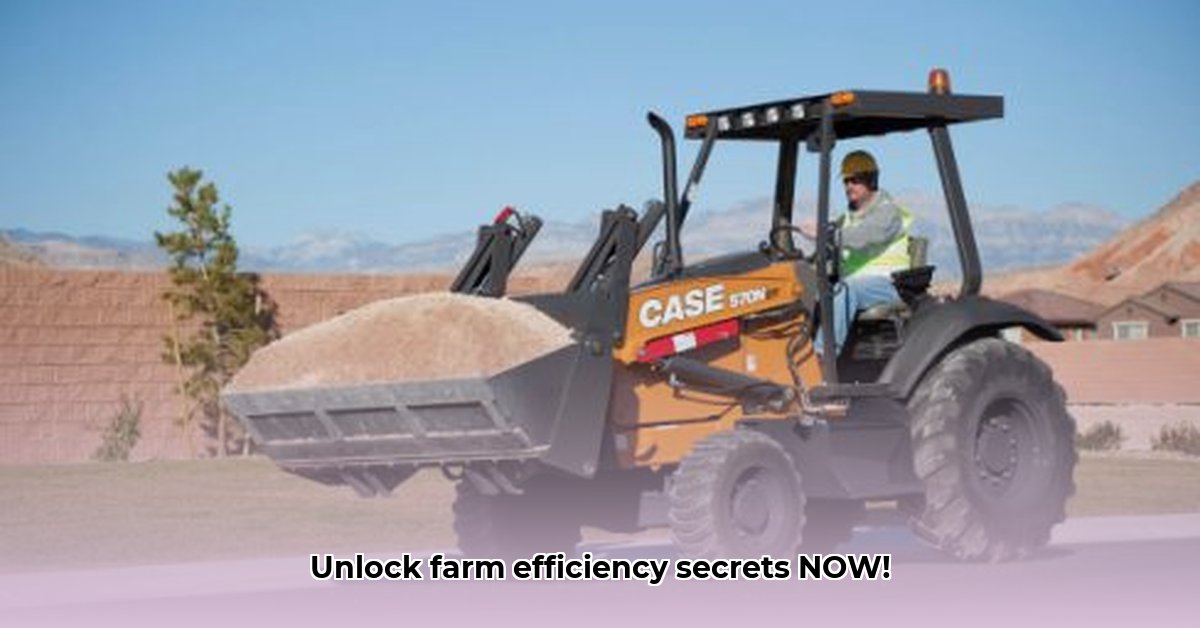
Case Tractor Loaders: Boosting Farm Efficiency and Yield
Modern agriculture demands efficiency and sustainability. Case IH tractor loaders are increasingly vital tools for achieving both. This article analyzes Case IH's offerings, focusing on how they enhance farm operations while considering environmental impact and long-term costs. We'll explore the benefits of integrated systems, examine sustainability considerations, and provide actionable recommendations for farmers, manufacturers, and policymakers. For more information on compatible attachments, check out these loader buckets.
Case Tractor Loaders: More Than Just Muscle
Case IH loaders, notably models like the 570N EP, provide substantial lifting capacity (upwards of 6,503 pounds in some configurations), handling diverse tasks with ease. However, their strength is complemented by features enhancing operator comfort and precision. Comfort Steer™, for example, reduces operator fatigue during extended use. The adaptability of these loaders, through a wide range of compatible attachments, significantly increases their versatility. This flexibility transforms them from simple material handlers into multifaceted tools for excavation, material movement, and a variety of other agricultural tasks.
The Advantages of Integrated Loader Systems: Streamlining Your Farm
Integrating loaders directly onto tractors offers substantial efficiency gains. The constant availability of the loader eliminates time-consuming equipment changes, minimizing downtime and maximizing productivity. This integrated design is central to the operational advantages of Case IH loaders. The adjustable rear hitch on models like the 570N EP further improves precision, often allowing for fewer passes across the field, directly leading to fuel savings and reduced soil compaction.
Sustainability Considerations: A Balanced Approach
While productivity gains are significant, environmental considerations are paramount. While comprehensive data on the fuel efficiency and emissions of Case loaders is still limited, a cautious assessment of both positive and negative environmental impacts is critical. Reduced passes across fields contribute positively by decreasing soil compaction and fuel consumption. However, the increased weight of the integrated system and potential for misuse could conversely increase soil compaction and negatively impact biodiversity. Responsible operation and careful implement selection are crucial for mitigating these potential negative impacts. Further research is needed to fully quantify the long-term environmental effects.
The True Cost: A Comprehensive Cost-Benefit Analysis
Investing in a Case IH loader requires a thorough cost-benefit analysis. The initial purchase price is only one component of the overall cost. A comprehensive assessment must also include factors such as fuel savings, reduced labor costs (resulting from increased efficiency), maintenance expenses, and the loader's expected lifespan. Comparing the total cost of ownership (TCO) to alternatives, such as smaller or less powerful equipment, is vital for making an informed decision.
Implement Selection & Optimization: Maximizing Loader Performance
The effectiveness of any loader is heavily dependent on selecting the appropriate implements for each task and soil condition. A pallet fork, for example, is ideal for moving materials, while a bucket is essential for excavation. Choosing the correct implement maximizes efficiency and minimizes wear and tear on both the implement and the loader itself. Many Case loaders are also compatible with precision agriculture technologies, further enhancing operational precision and efficiency.
Actionable Recommendations: A Practical Guide
To fully utilize the potential of Case IH loaders, consider these actionable steps:
- Assess Farm Needs: Carefully identify all tasks and soil conditions to determine the optimal loader size and configuration.
- Thorough Research: Investigate the full range of Case IH loader models and compatible attachments to ensure a perfect match for your specific requirements.
- Comprehensive Cost Analysis: Conduct a detailed TCO analysis, considering all relevant costs over the loader's expected lifespan.
- Prioritize Sustainability: Implement operating procedures that minimize environmental impacts. Choose implements strategically to reduce soil compaction and fuel consumption.
- Technology Integration: Explore how integrating precision agriculture technologies can further enhance efficiency and data collection.
Conclusion: Harnessing Technology for Sustainable Farming
Case IH tractor loaders offer substantial potential for improved farm efficiency and productivity. However, responsible farming necessitates a balanced approach. Further research is crucial to completely understand the long-term environmental repercussions of these powerful machines. Ongoing study into fuel consumption, emissions, and soil health is vital. The future of sustainable agriculture relies on this continued investigation and development of increasingly efficient and environmentally conscious solutions.
Risk Assessment Matrix (Example)
| Potential Hazard | Likelihood | Severity | Mitigation Strategies |
|---|---|---|---|
| Soil compaction | High | Medium | Reduce passes, use appropriate tires, implement selection |
| Equipment malfunction | Medium | High | Regular maintenance, operator training, preventative maintenance schedules |
| Operator injury | Low | High | Safety training, proper PPE, regular safety inspections |
| Environmental damage | Low | Medium | Responsible operation, implement selection, adherence to environmental regulations |
(Note: This is a sample matrix. A thorough risk assessment specific to your operation and loader model is essential.)